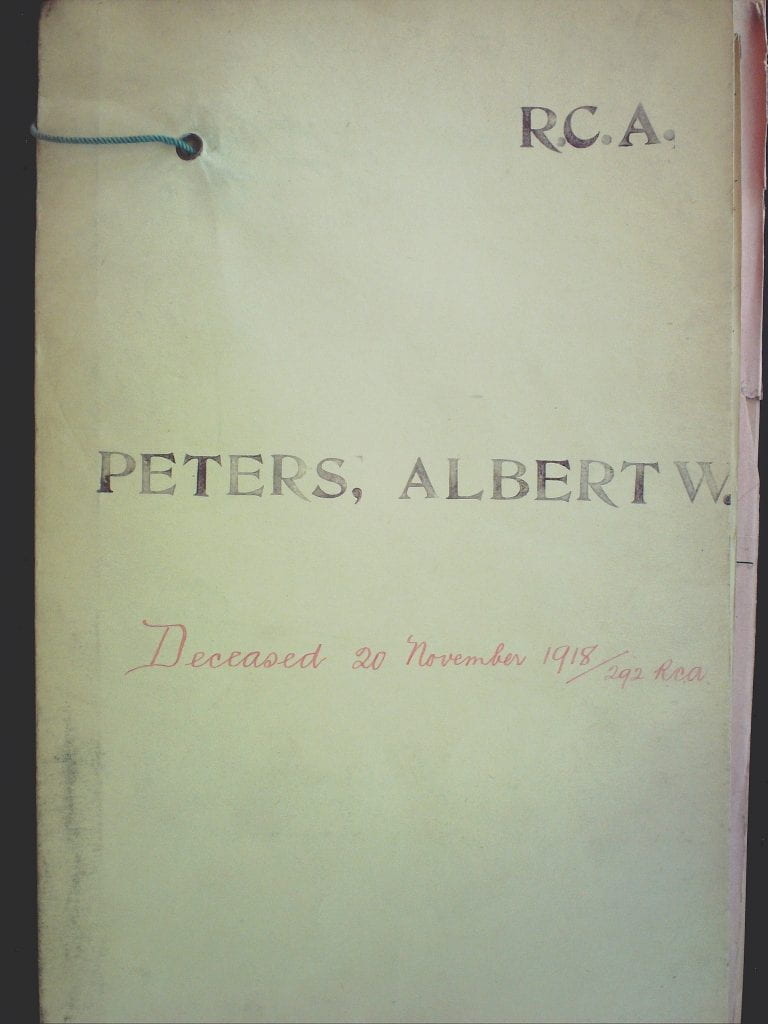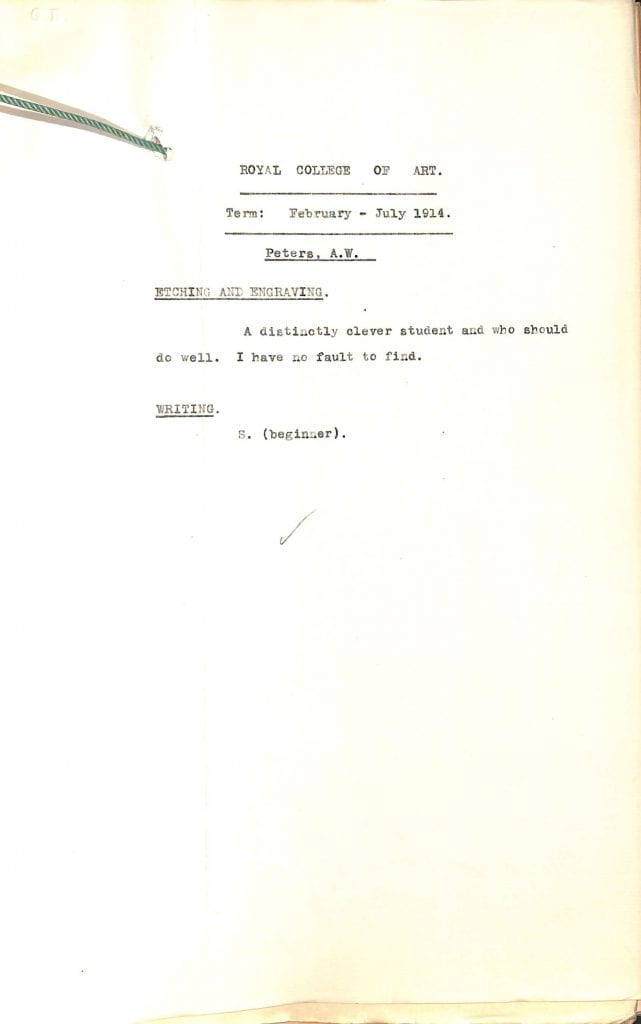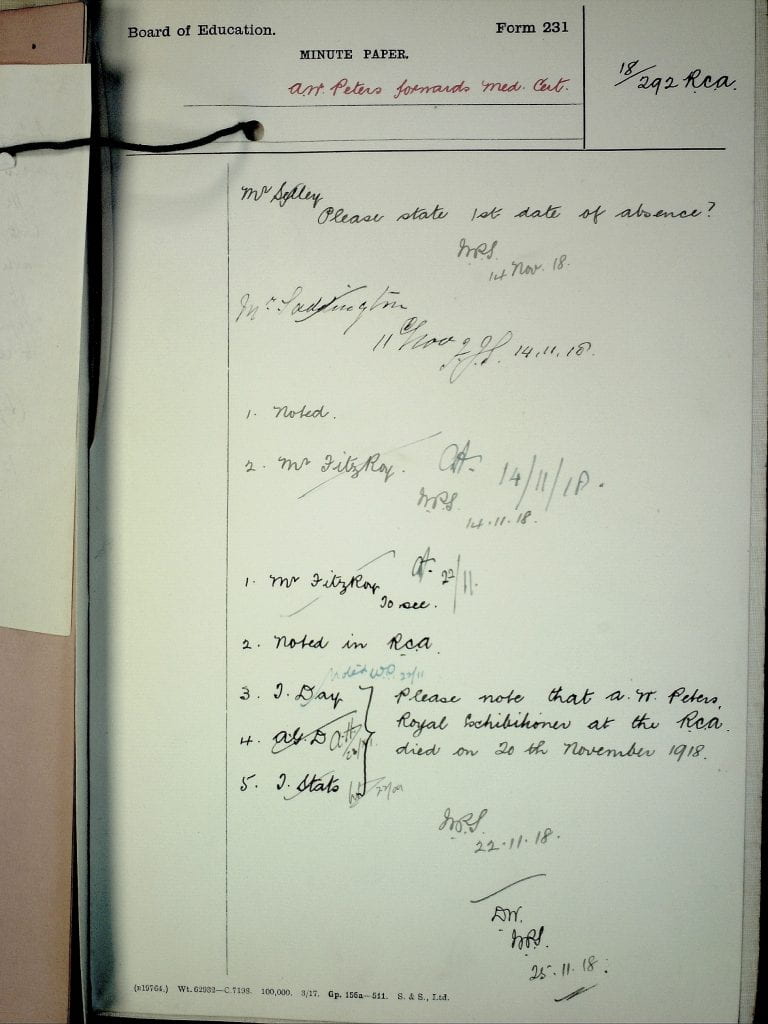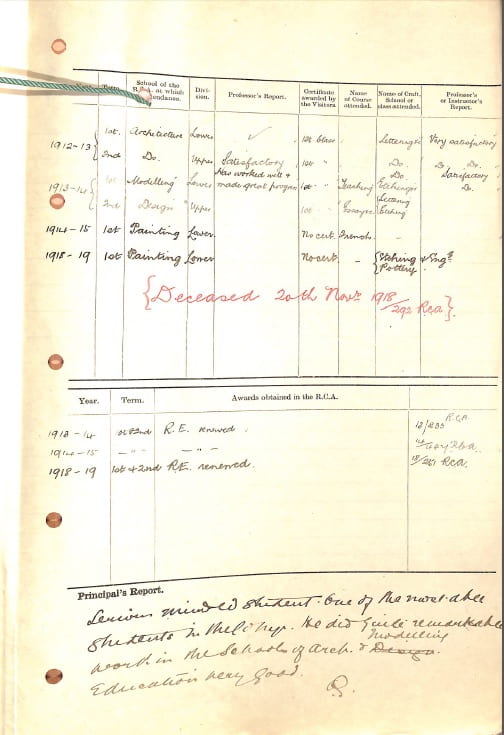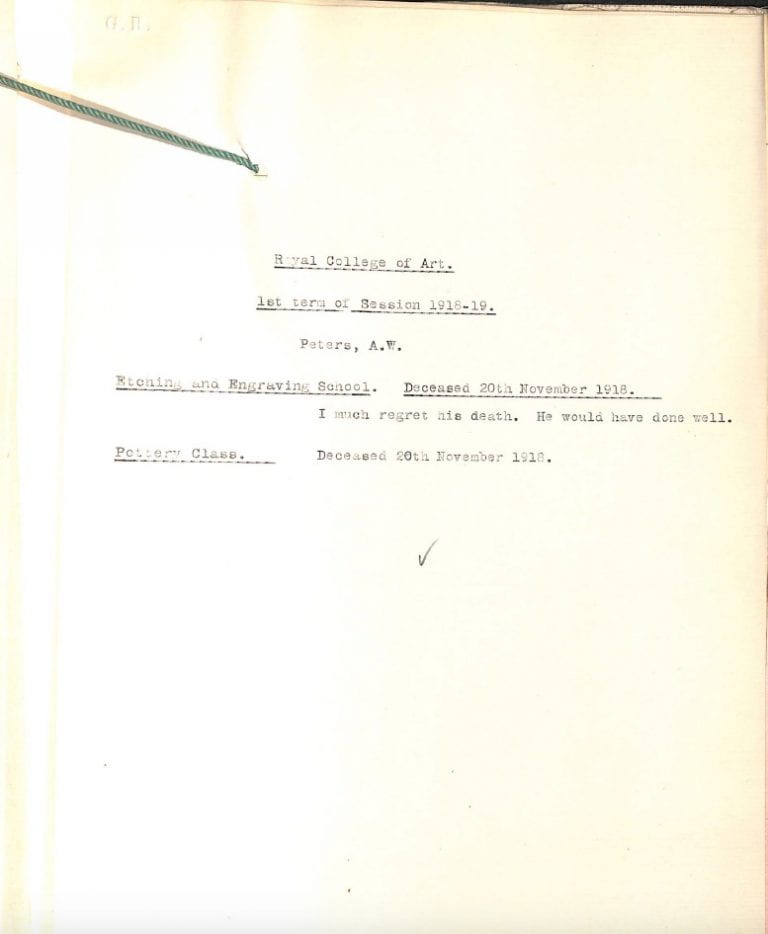Born: 9 November 1894
Died: 20 November 1918
Studied at RCA: 1912 -1914
Albert was one of four children born in West Bromwich to a hosier and clothing dealer, John Albert, whose wife Elizabeth and oldest son, as well as the elder of two daughters, worked alongside him in the family business at the time of the 1911 Census. Before he arrived at the RCA intending to become a teacher, Albert had attended the local school of art for four years. Its ambitious headmaster was J. A. Pearce – himself a former student at the College.
Albert’s ability was apparent as a teenager. He gained the distinction of coming first in the Board of Education national exams for ‘drawing from the antique’, recorded in the Birmingham Daily Gazette in April 1911, with later reports in his College student file noting that he was considered to be ‘one of the most able students we have had…’ and that ‘he did quite remarkable work’ in the School of Modelling. A sketch he made of the Professor of Engraving, Frank Short, now in the collection of the National Portrait Gallery, and a series of drawings of animals later published by A&C Black as The Zoo (1915) probably date from 1914 – before war was declared – seem to indicate his confidence in himself. But, like many others, Albert left his studies behind when he volunteered for military service at Chelsea Town Hall on 12 October 1914. A couple of days later he became a trooper with ‘The Blues’, the Royal Horse Guards, based at their Regents Park Barracks, with another student P. R. Paul, joining them too by the end of the month.
Just six months later, in mid-May 1915, Albert arrived in France, probably in a draft of twenty-six men that joined the 8th Cavalry Brigade in the 3rd Cavalry Division based in and around Ypres. From their war diaries it appears that they often served dismounted, participating in what became the increasingly familiar trench warfare. Their war diary provides contrasting views of the 8ths, with an unnamed Field Marshal complimenting them on their ‘extraordinary smart and soldierlike appearance’ while in July they were commended for their construction work between Hill 63 and Neuve Eglise. It was the latter skill that took precedence over horsemanship as the war continued.
No mention is found of Albert during this time, or when the brigade supported French divisions at the Battle of Loos towards the end of September to mid-October 1915. But by the end of February 1916, as things became relatively quiet for the Royal Horse Guards, Albert applied for a commission with his good moral character references supplied by the College’s Frank Short, and Augustus Spencer, the Principal. More significantly Albert specified on his application that he wanted to serve in the infantry in future, with at least one of his army forms noting he was already qualified as a machine gunner – a role that seems incompatible with riding a horse.
Albert returned from France on 5 April 1916 to spend the rest of the year training as an officer, perhaps first based at The Curragh in Ireland and, from September, at Bisley in Surrey. He would no longer be on horseback, but nor was he to serve in the infantry: Bisley was where training in the use of a new top-secret weapon had begun in June. Albert was to serve in the Machine Gun Corps, Heavy Section: a name designed to conceal that the men were actually learning to handle land battleships also described as ‘tanks’ – as in water tanks – another attempt to maintain secrecy. Albert gained his commission to temporary Second Lieutenant at the end of November.
The first deployment of Mark I tanks at the Battle of Flers-Corcellette in September 1916 – the same month as Albert’s transfer to Bisley – revealed their many shortcomings. They were slow and unsuitable for the muddy conditions – they toppled over with no reliable way to be righted, operating them was dangerous for their eight-men crews with cramped conditions contributing to very high temperatures when enclosed, visibility was poor, and last, but not least, little consideration had been given to communication inside or with those outside. Wartime, however, is always a period of rapid technological innovation, and during the summer of 1917, when Albert reappears in accounts, he is noted as the commander of a Mark IV (a slight improvement on previous models) with 18th Company, F Battalion in the recently formed Tank Corps, part of the 61st Division.
Albert and his crew were to take part in the Third Battle of Ypres. He was in a section totalling eight tanks acting, at least theoretically, in pairs, with one leading and another in support. Their target on 22 August was a group of heavily fortified farm buildings between the village of St Julien and Gravenstafel towards the Belgian border. All the numbered tanks were given names based on their F initial: Albert and his crew were in Faun (F42) supported by Fay (F46). The operation did not go well from the start, with the war diary recording that early on, Faun
‘…Received direct hit while lined up at Starting Point before ZERO, putting one turret out of action on right side, and wounding one man. Proceeded at ZERO for about 200 yards under heavy fire, and then became ditched. The officer and all the crew became casualties while putting on unditching gear.….’
This was the same operation that became famous for a three-day siege of another tank in the section, Fray Bentos (F41) which while under attack from German forces also had to deal with potential threat from their own side, unaware that there were surviving crew stuck inside.
During the action Albert sustained an injury to his left knee, caused by either a bullet or a piece of a shell. He was evacuated to a hospital in Rouen and then shipped back to England, with his medical records indicating that an infection prevented healing of the entrance wound. While doctors were able to reduce the swelling, and control the pain, ‘Movement was almost entirely absent’.
During the autumn until mid-May 1918 Albert was transferred from one medical facility to another until it became clear that he would be permanently disabled and unfit for ‘general service’, ‘service in a garrison labour unit abroad’, or ‘active duty with troops’. This left sedentary work, and the threat of this was such that he wrote an urgent, unpunctuated objection to the War Office in May mentioning he had ‘…no office experience of any kind my profession before the war being a Black and White artist Therefore I am afraid I am no use to you’. The army seem to have agreed, and he relinquished his commission due to his ill health on 1 June 1918. By October he had returned to his studies at the College, taking up his scholarship once more.
Albert was noted as absent from College on Monday 11 November, the day the armistice was signed and two days after his twenty-fourth birthday. On the Tuesday a doctor wrote to the College advising that Albert ‘was confined to his bed with influenza, & quite unable to attend to his studies’. While it was thought it would take a week for him to recover, Albert’s condition instead worsened. He had apparently contracted pneumonia, noted in a letter from his father in Albert’s service file. This was a common complication during the devastating pandemic. He died at St Mark’s Army Hospital in Chelsea a week later.
A report of Albert’s first session of the academic year contains a brief, poignant note, probably written by Frank Short, ‘I much regret his death. He would have done well’.
Albert is buried in St. John the Evangelist Churchyard, Perry Barr, Birmingham.
